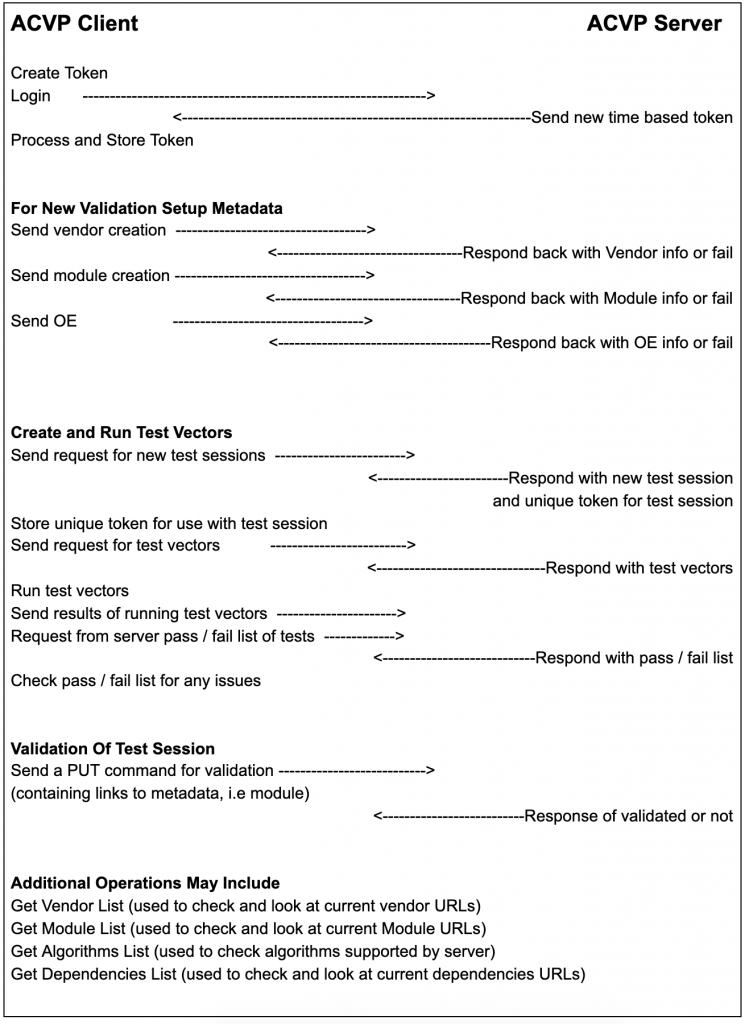As many in the FIPS world are aware NIST retired CAVP (Cryptographic Algorithm Validation Protocol) testing on June 30th of 2020, permanently replacing CAVP with ACVP (Automated Cryptographic Validation Protocol), also referred to as ACVTS (Automated Cryptographic Validation Test System).
In order to prepare for this transition NIST offered a “demo server” that Vendors like wolfSSL and FIPS Labs could utilize in standup of the new protocol. Once the transition was completed NIST also setup “production servers” which only FIPS Labs with a trusted certificate issued by NIST can connect to; Production Vectors passing are now the gateway to Algorithm Certification (IE certs like the ones wolfSSL just received!).
Algorithm Certification is a prerequisite to CMVP FIPS 140-2 (and 140-3) validations. This design keeps in place the need for a FIPS lab to achieve algorithm certification but it now allows for Vendors such as wolfSSL to pre-test in advance of requesting production vectors for certification! wolfCrypt has been listed on the CMVP IUT List for FIPS 140-3! We are currently working with our testing lab to get validated as quickly as possible with the new FIPS standard from the NIST. wolfSSL is the first software library on the FIPS 140-3 IUT list for embedded development.
Concurrently wolfSSL is also in the process of developing our own ACVP client based off of the current draft (draft-fussell-acvp-spec-01). Having many algorithms already completing the validation process through the NIST operated ACVP Demo server. Where our test vendor information can be seen publicly listed on the demo site here (https://demo.acvts.nist.gov/home).
More on ACVP’s
ACVP stands for (Automated Cryptographic Validation Protocol) and it is the upcoming protocol that will be used for FIPS validation. This is going to be a prerequisite certificate for the CMVP(Cryptographic Module Validation Program) and CAVP(Cryptographic Algorithm Validation Program) certificates.
ACVP makes testing cryptographic algorithms and modules more efficient than the current method and more automated. There are three main parts to ACVP – a server, a proxy, and a client.
- The server side handles requests for test vectors and requests for validation among other requests. This side is operated by a FIPS lab or by NIST themselves.
- A proxy with ACVP can be used to communicate to offline systems and handle transferring information from the system being tested to the server. Often an ACVP client is used instead.
- The last part being a client, which is most relevant to users who are wanting to get their cryptography FIPS validated. An ACVP client is directly hooked up to the module to be tested and then communicates with the ACVP server to send requests for test vectors, responses of the results from running those tests, and requests for algorithm validation. There are multiple pieces required to build a ACVP client in order to complete a validation process, some of the large portions of the effort go into
- JSON parsing / creation for communication with a ACVP server
- HTTPS GET / POST / PUT / DELETE messages used for securely transporting information
- 2 factor authentication with TOTP (Time-Based One-Time Password Algorithm)
- Plugging in the test harness that runs crypto operations
Ultimately an ACVP client communicates with the server to validate cryptographic operations. This includes creating, or referencing meta data such as; vendor, OE, and module information. A simplified message flow for getting an algorithm validated is as follows:

We can assist with your FIPS needs.
If you have any questions or run into any issues, contact us at facts@wolfssl.com, or call us at +1 425 245 8247.
More information from NIST’s website about the ACVP project can be found here:
https://csrc.nist.gov/Projects/Automated-Cryptographic-Validation-Testing.

